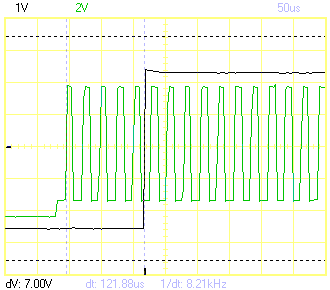On the previous page, we learned that the Vishay TSOP4038 can replace the Panasonic PNA4602M infrared detector. In fact, the TSOP 4038 is smaller, uses less power, has a wider voltage range, and a greater detection distance. Most importantly, the PNA 4602 is obsolete (discontinued) and no longer available.
The TSOP4038 has another advantage -- it appears to produce fewer false detection spikes. For example, when no target was present, the PNA4062 shows random intermittent pulses.

Random detection spikes
On average, in my test apparatus, the spikes occur about 0.3% of the time when a 38 kHz wave is being emitted without a nearby target. The spikes drop to 0 when the infrared emitter is disconnected, even if the 74HC14 logic chip is still generating a 38 kilohertz oscillation. This suggests that either the test surface or another object is reflecting some of the signal, rather than electrical signal leakage from the circuit board.

PNA4602 length of average false detection spike
Most of the spikes are 170 microseconds in length. Robots or devices designed to use the PNA4602M have come to expect such noise, and are designed to tolerate or ignore it.
Interestingly, the TSOP4038 produced no spikes when the target was beyond 100 centimeters with a single infrared LED at 2 mA. Unless your robot uses the spikes for random number generation or to break movement deadlocks, the TSOP4038 should provide slightly better noise performance when replacing the PNA4602M.
When listening for a 38 kilohertz signal, how many rising and falling changes should indicate reception? I suppose at least one of each is necessary to define a single wave. But, if the detector triggers too easily, then false noise spikes will occur.


PNA4602 time to start detection and stop detection
The Panasonic PNA4602M takes about five pulses (around 122 microseconds) to initially detect a signal when the target is at 20 cm. It takes about seven pulses (around 180 microseconds) to output that the signal has ended.
In comparison, the TSOP4038 takes longer:


TSOP4038 time to start detection and stop detection
The Vishay TSOP4038 takes about nine pulses (around 233 microseconds) to initially detect a signal. It takes about fourteen pulses (around 369 microseconds) to output that the signal has ended.
The differences in the latency (delay) between the beginning and end of detection of a signal may be enough to cause incompatibility in substituting the PNA4602M with the TSOP4038. However, this would not be a problem in either the obstacle detection or remote control command circuits that I’ve developed so far. If your circuit is really that sensitive, then I submit that the lack of wider tolerance is weakness that may be causing other problems as well.
Perhaps the reduction in false spikes comes at the price of a longer delay in detection. Next, we'll see how these tests were performed.